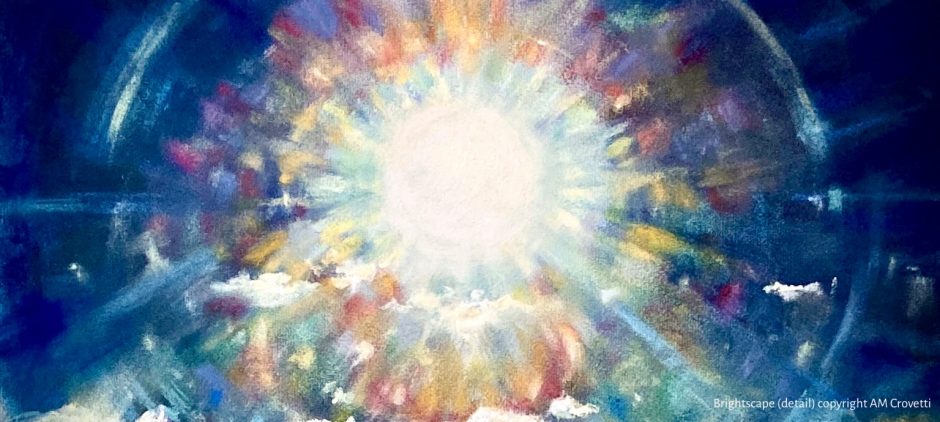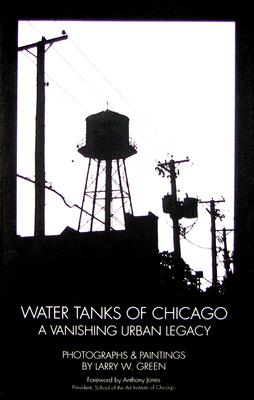It is a role of the artist to bring attention to what might otherwise be missed. So it was that I discovered the plight of Chicago’s crumbling water tanks when I picked up Larry W. Green’s slim book of photographs and paintings, Water Tanks of Chicago: A Vanishing Urban Legacy. (Chicago: Wicker Park Press, 2007). The tanks—treasures of redwood and cypress, symbols of the city’s past—might be dwindling to the point of extinction, but Green’s art continues to celebrate the brawny artifact of Chicago’s ever-changing landscape. The artist himself, having been diagnosed with renal failure a few years back, knows something of the struggle for survival.
Green, born in Terre Haute, Indiana, is a 1975 graduate of the Art Institute of Chicago. On a sunny Thursday morning in April, I drove to meet the artist at his studio in East Garfield Park. When I arrived, Green came around the side of his old van to greet me and lead the way through the artists’ co-op, up to his second story, light-filled studio. A profusion of rooftop tanks—dark silhouettes against blue skies and sunsets, lone sentinels posted in forgotten urban landscapes, and miniature versions the size of my palm—bespoke of the strange and mysterious passion which overcomes many an artist. Green’s fascination with the subject matter has served to keep the water tanks alive in the memory of many a collector.
The water tanks are a legacy of the Great Chicago Fire of 1871. After the disaster, it was decided that every public building and warehouse would have its own means to fight fire—an ingenious solution powered by gravity in an era before there were electric-powered water pumps. In an effort to keep the last remaining tanks part of the skyline, preservationists have sought ordinances, and in 2006 Mayor Daley sponsored an architectural contest in which the purpose of the defunct tanks was to be re-envisioned. In the minds of the contestants, the tanks became bird sanctuaries, giant planters, wind turbines, or sculpture gardens. Despite the visions of the architects, the tanks—prone to decay when devoid of water—continue dwindle in number.
Although the water tanks might be losing their battle, the artist who paints them and who only recently suffered from end-stage renal failure is now fully recovered. About two years ago, Green grew weary of waking up at 5:30 a.m. and reporting to the Logan Square dialysis clinic three times a week. Taking matters into his own hands, he decided to put a “kidney wanted ad” on craigslist. While a fee for organ donation was not offered (and cannot be legally offered), Green received three replies to his request. A young woman from Haiti turned out to be a match. Inexplicably the woman, seeking no financial reward, felt compelled to help a complete stranger in this manner. In a matter of months, Green got his life back.
I asked him if the experience of being diagnosed with end stage renal disease and the miraculous recovery that followed changed him and his art. He replied that it had. Small, everyday problems we all face seem inconsequential in comparison with the matter of life and death. Furthermore, he has managed to persevere in the practice of his chosen craft. At a time when it is difficult to convince much of the public of the virtue of art over mass merchandise, he has accomplished an amazing feat. Over four decades, he has maintained his identity as a painter and amassed an impressive body of work. He shares his sunny studio space with his wife—who is also a talented painter—and enjoys his two bright, nearly grown children.
It was impossible for me to leave Larry Green’s studio without purchasing one of his pieces. I selected a miniature—a dark silhouette against a cerulean blue sky. It now hangs in my kitchen, offering a reminder of my visit to his studio. I imagine the wooden tanks will continue to disappear from the rooftops of Chicago, but at least Larry Green’s paintings and photographs will keep the memory of the forgotten skyline alive. Art has a way of reminding us who we are, of where we have been, and what is important.
Larry’s book, Water Tanks of Chicago: A Vanishing Urban Legacy is available for purchase on Indiebound (or on Amazon if you must). The book is perfect for father’s day. Buy art, support artists, and your community. You can view more of Larry Green’s work at http://larrywgreen.blogspot.com.
To learn about resources for those fighting kidney disease or to make a donation, you can visit the Renal Support Network.



